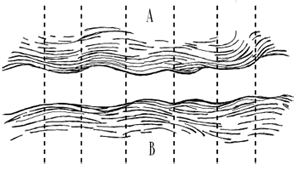'Montrer au linguiste ce qu'il fait' - Revisiting De Saussure from an experimental perspective on language play
'MONTRER AU LINGUISTE CE QU'IL FAIT'
Revisiting De Saussure from an experimental perspective on language play
One of the more interesting laboratory experiments in linguistics of recent years is that by Kirby et al. (2008), where participants, with the help of pictures of objects, had to learn a series of randomly constructed nonsense words, which they then had to pass on to a new group or 'generation' of people. The outcome was that within ten 'generations' a new language had come into being, with rules for form, meaning and usage of the elements concerned – rules that were made up and produced through the learning and transmission activities of the successive generations, who thus transformed an un-ordered collection of random and intransparent letters, sounds and visual material into a regularly structured language system.
This ability to make language, grammar, structure and meaning, is in line with the constructionism of Tomasello (2003). Conversely, through a game like Chinese whispers or téléphone arabe, utterances with a clear and well-defined form and meaning can be garbled into utter incomprehensibility. To account for such abilities, what is needed is "an inquiry into the structuration, restructuration and destructuration of language" (Jakobson & Waugh 1979: 237). Where Kirby, Tomasello, Jakobson and Waugh see the above as processes of (de-/re-) structuring, this reflects their indebtedness to the Cours de Linguistique Générale (CLG) of 1916; while, at the same time, Saussure's notions of 'language system' and 'structure' have had to be thoroughly reworked as well.
What I want to discuss in this presentation is a perspective on the future of linguistics as an experimental discipline in which we systematically explore the empirical and theoretical aspects of such structuration processes. My focus here will be on the data on language play from the experiments by OULIPO and other recreational linguists (Bloomfield & Lesage 2014).
What studying language play demonstrates is how human language is an inexhaustible source of innovation and creativity. At any level of the language system, there is always the potential for new formations, combinations and associations; while, at a deeper level, language play offers insights into the forces driving the dynamics of language (Crystal 2001, Calvet 2011). That is, far from being the marginal phenomenon it was in Saussure's CLG, language play actually has a central role - not only in the langue, but also in parole, synchronie, diachronie and at the level of his faculté linguistique.
The question before us here is how these findings from language play and experimentation matter to the intellectual apparatus of linguistics as it has evolved over the past century (cf. Chevalier 2006). This vital question will take us into Saussure's exploration of anagrams (Testenoire 2013), and especially into his longstanding epistemological reflections concerning the third task he saw for linguistics, viz. "de se délimiter et de se définir elle-même"(CLG: 20) - or, as he put it in 1894, to 'montrer au linguiste ce qu'il fait' (Saussure 2002: 12).
Bloomfield, Camille & Claire Lesage (eds.)(2014). OULIPO. Ouvroir de littérature potentielle.
Paris.
Calvet, Louis-Jean (2010). Le jeu du signe. Essai. Paris.
Chevalier, Jean-Claude (2006). 'Le vingtième siècle, a-t-il été le siècle de Saussure?' In: Jean-
Claude Chevalier avec Pierre Encrevé (eds.) (2006). Combats pour la linguistique, de
Martinet à Kristeva. Essai de dramaturgie épistémologique. Lyons, 297-301.
Crystal, David (2001). Language Play. Chicago.
Jakobson, Roman & Linda Waugh (1979). The sound shape of language. Brighton.
Kirby, Simon et al (2008). 'Cumulative cultural evolution in the laboratory: An experimental
approach to the origins of structure in human language'. In: PNAS 105, 31, 10681-
106886.
Saussure, Ferdinand de (2002). Écrits de linguistique générale. Ed. Simon Bouquet & Rudolf
Engler. Paris.
Tomasello, Michael (2003). Constructing a language. A Usage-Based Theory of Language
Acquisition. Cambridge, MA.
Publication version PDF

